|
Books Should Be Free Loyal Books Free Public Domain Audiobooks & eBook Downloads |
|
|
Books Should Be Free Loyal Books Free Public Domain Audiobooks & eBook Downloads |
|
Fiction |
|---|
|
Book type:
Sort by:
View by:
|
By: Mary Elizabeth Braddon (1835-1915) | |
|---|---|
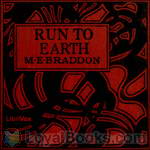 Run to Earth
Run to Earth
A captivating Victorian “sensation” novel by the author of Lady Audley's Secret, Run to Earth has it all: scoundrels and mercenaries, love and lust, jealousy, intrigue, and suspense. (Introduction by Gail Mattern) | |
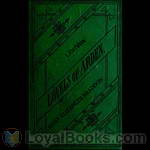 The Lovels of Arden
The Lovels of Arden
The novel traces the return of a young Englishwoman from several years of schooling abroad, to find that her life will not take up where she thought it would. Clarissa Lovel faced not only an emotionally and financially bereft father, but her first glimpse at love - and that not from the best vantage point. | |
 Birds of Prey
Birds of Prey
The first part of the book builds the characters of four con men who become interconnected and attempt their schemes on each other. This book is the first of a two part story, the second part is the book Charlotte's Inheritance. | |
 Cut by the County; or, Grace Darnel
Cut by the County; or, Grace Darnel
Darnel Park is situated in a county that thrives on gossip and secrets, and the Darnel family, as it turns out, has many of them. An attempt at Sir Allan Darnel’s life, after various misunderstandings and misdirections, reveals an estranged son and a mysterious fiancée, and the Darnel family scrambles to conceal these new developments from not only the county but the Scotland Yard detective called in to investigate. - Summary by Adrienne Prevost. | |
 Aurora Floyd Volume 2
Aurora Floyd Volume 2
Aurora Floyd is the spoiled, impetuous, but kind hearted daughter of Archibald Floyd, a wealthy banker and his wife, an actress who died shortly after Aurora's birth. As a teenager she is sent away to finishing school in Paris. This is volume two of the story which tells of Aurora's life with her husband John Mellish. This is a story of love, murder and the search for justice. - Summary by Michele Eaton | |
 Mount Royal Vol. I
Mount Royal Vol. I
A classic Victorian sensation novel filled with romance, mystery, and murder with the emphasis on romance. -summary by Celine Major | |
 Mount Royal Volume II
Mount Royal Volume II
A classic Victorian sensation novel filled with romance, mystery, and murder with emphasis on romance. - summary by Celine Major | |
 Mount Royal Volume III
Mount Royal Volume III
A classic Victorian sensation novel filled with romance, mystery, and murder with emphasis on romance. - summary by Celine Major | |
 Strangers And Pilgrims
Strangers And Pilgrims
Strangers and Pilgrims follows the journey of Elizabeth Lutterell from a vain, beautiful and self-centred although good-hearted 19 year old to a mature woman. She begins her journey to maturity when she meets the Rev. Malcolm Forde, whose influence opens her eyes to the trivial and selfish ways of the wealthier levels of society. When her genuine love for Malcolm Forde is thwarted and she becomes trapped in a cold, loveless marriage of convenience, she suffers illness, tragedy and regret. Will she find ultimate happiness? A hugely prolific and popular author, M... | |
 Fatal Three
Fatal Three
Written by one of the most prolific authors of the 19th century The Fatal Three although not as sensational as some of her other novels serves up some very fascinating characters. It also raises some very interesting questions regarding moral & religious education, Victorian marriage laws, mental illness and how one's upbringing can determine one's fate. Delightful country homes and exquisite scenery provide the usual perfect backdrop for this enjoyable read by Mary Elizabeth Braddon. - Summary by Celine Major | |
 Lady's Mile
Lady's Mile
If you drive through the Lady's Mile, the most fashionable district in London, you will see people whose most distinguished ambition was to be known in that circle. A novelist, a painter, and some aristocrats, willing to prove themselves to the world. But what happens behind closed doors? Is the Lady's Mile as respectable as it seems? - Summary by Stav Nisser. | |
 Vixen
Vixen
This is an exquisite and heartbreaking love story. Violet Tempest and Roderick Vawdrey, otherwise known to each other as Vixen and Rorie, are childhood sweethearts. However, Rorie's family wants him to marry elsewhere. You may think it is the old story all over again, but nothing in this novel is what it seems. It is far too realistic for that. Many books talk about falling in love. This book starts after that stage, and speaks about the harder stage of a relationship: loving earnestly but understanding that love - even in the truest and purest sense - is not everything in life... | |
 Wyllard's Weird
Wyllard's Weird
A novel written in three volumes. In the golden age of steam, the London train wends its way across the Tamar into the strange and mystic land that is Cornwall, having left most of its length at Plymouth. A weary doctor gazes at the countryside, when the train grinds to a halt and his professional attention is demanded. A young woman. An apparent suicide. Who was she? What brought her to Cornwall? What drove her to kill herself? Or did she? | |
 Christmas Hirelings
Christmas Hirelings
It is the Christmas season once again and things are, well, boring for the adults at Penlyon Castle. "...if somehow or other I had a pack of children belonging to me, I would keep Christmas with the best — keep it as it ought to be kept." says Sir John. His good friend Mr. Danby has the perfect solution - to hire some children to spend Christmas! Thus, the arrival of Lassie, Laddie, and little Moppet - Christmas and Sir John may never be the same again. Proof Listener - hallejk | |
By: Mary Elizabeth Hawker (1848-1908) | |
|---|---|
 Mademoiselle Ixe
Mademoiselle Ixe
This is a story by the English writer Mary Elizabeth Hawker (1848-1908) entitled Mademoiselle Ixe, by[pseudonym] Lanoe Falconer. The manuscript had been previously rejected by many publishers. The heroine is a governess in an English country house. The mystery is cleverly handled, and the artistic treatment showed a delicacy and refinement which were uncommon in English writers of short stories. The Saturday Review declared it to be 'one of the finest short stories in England.' Success was great and immediate... | |
By: Mary Godolphin (1781-1864) | |
|---|---|
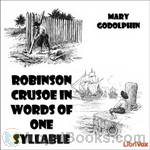 Robinson Crusoe in Words of One Syllable
Robinson Crusoe in Words of One Syllable
Mary Godolphin was the pseudonym of Lucy Aikin who undertook translating great literature into single-syllable words so that young readers could enjoy plots that were considerably more interesting than, say, the McGuffey readers of the 1880’s or the “Dick and Jane” primers of the 1950s (still around today as “decodable readers” in elementary schools). She produced this volume based on Daniel Defoe’s most famous work, considered by many to be the first English novel (1719). She also rendered Bunyan’s Pilgrim’s Progress and Wyss’ Swiss Family Robinson, which she translated as well. | |
By: Mary Grant Bruce (1878-1958) | |
|---|---|
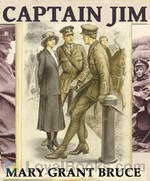 Captain Jim
Captain Jim
This book is about Norah Linton, her brother Jim, her father David and Jim's chum Wally from Australia. They all move to England during WWI because Jim and Wally want to fight in the war.When a Irish friend of the family dies, Norah inherits a big house in Surrey: Homewood. To keep up the Irishman's memory they want to use the house to help the war effort. They turn it into a home for "Tired People"--soldiers recovering from injuries, or soldiers on leave that have no family to go home to, can come here to have a good time and enjoy the country-side, so that they can go back to their regiments fully rested and restored... | |
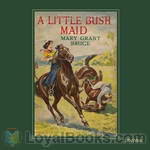 A Little Bush Maid
A Little Bush Maid
An Australian childrens' classic about life on a ranch around the same time of A Little Florida Lady, with a similarly plucky tomboy heroine. Also, like the latter story, expect some racial stereotyping of Asian and Aboriginal characters. This originally ran as a newspaper serial and it shows in the episodic nature of the chapters, such as a vivid trip to the circus sandwiched by talk of a mad killer and an unexpectedly sentimental ending. | |
By: Mary H. Northend (1850-1926) | |
|---|---|
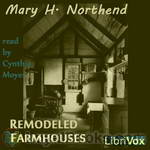 Remodeled Farmhouses
Remodeled Farmhouses
"There is a certain fascination connected with the remodeling of a farmhouse. Its low, raftered interior, its weather-beaten exterior, never fail to appeal. Types vary with the period in which they were built, but all are of interest. In this collection, which has been pictured with great care, pains have been taken to show as many different types as possible, so that the student will be able to find numerous interesting details that can be incorporated into his contemplated remodeling." [opening lines of Preface] | |
By: Mary Hastings Bradley (d. 1976) | |
|---|---|
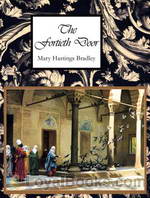 The Fortieth Door
The Fortieth Door
Romance, sinister strangers, plenty of skulduggery, mysterious beauties cloaked in veils, dungeons and crypts, dreadfully wrapped mummies and evil doings will all envelope you in this book. If you're looking for a truly satisfying read, The Fortieth Door by Mary Hastings Bradley is definitely your pick! Born in 19th century Chicago, Mary Hastings Bradley studied English literature at Smith and after her graduation, she found herself at loose ends. When a cousin invited her to join her on a trip to Egypt, Mary gladly agreed... | |
By: Mary Hazelton Blanchard Wade (1860-1936) | |
|---|---|
 Our Little German Cousin
Our Little German Cousin
This book is part of the "Our Little Cousin" series, written for North American children to tell them about their 'cousins' from other parts of the world. Embark on a journey to 19th Century Germany with Bertha, Gretchen and Hans. They live in a toy-making village in the Black Forest. Learn about their work and customs; get to know facts and lore, hear about architecture, music and more. ( Claudia Salto) | |
By: Mary Heaton Vorse (1874-1966) | |
|---|---|
 Ninth Man
Ninth Man
A fictional town in Italy is conquered by a heartless tyrant. He issues a strange but cruel edict: in thirty days, each ninth person, chosen by lot, shall designate secretly whom he wishes put to death in the public place. | |
By: Mary Jane Holmes (1828-1907) | |
|---|---|
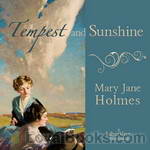 Tempest and Sunshine
Tempest and Sunshine
Tempest and Sunshine is the first book written by Mary Jane Holmes. Set in the pre-Civil War south, it follows the struggles and romances of two sisters, as different as night and day; blonde Fanny and dark haired Julia. (Introduction by jedopi) | |
 Cousin Maude
Cousin Maude
When Matilda's husband James dies, she marries rich Dr. Kennedy thinking he will provide a good home for her daughter Maude. However, the doctor is a miser and assumes that Matty will be his housekeeper. They have a little boy who is crippled and the doctor ignores him. Maude is totally devoted to him and on her mother's deathbed promises to look after him always. The story then evolves with Maude meeting her stepsister Nellie's cousins JC and James. Nellie has set her sights on JC who is after her money while Maude develops strong feelings towards James... | |
By: Mary Johnston (1870-1936) | |
|---|---|
 To Have And To Hold
To Have And To Hold
When I first started reading this book, I thought it to be a historical romance novel. As I read further, I pondered whether it might be a sea-faring story. Reading still further, I determined it to be an adventure story. Alas, it is all three. To Have And To Hold, written by Mary Johnston was the bestselling novel of 1900. The story takes place in colonial Jamestown during the 1600’s. Captain Ralph Percy, an English soldier turned Virginian explorer buys a wife - little knowing that she is the escaping ward of King James I... | |
By: Mary Katherine Maule (1861-0) | |
|---|---|
 Prairie-Schooner Princess
Prairie-Schooner Princess
The story of a Quaker family's journey from Ohio to Nebraska beginning in 1856. They encounter a mystery which leaves them an orphan girl who will forever change their lives. Blizzard, the Civil War, and Indians and more Indians fill this great adventure which tests their faith and ingenuity while shaping their loves and futures. | |
By: Mary Knight Potter (?-1915) | |
|---|---|
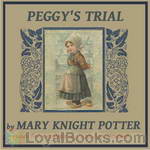 Peggy's Trial
Peggy's Trial
Ten-year old Peggy Clayton and her two younger brothers, Teddy and Harry, live with their father, Dr. Clayton, and Nurse, a woman who has taken care of them since the death of their mother when Peggy was five. Peggy is a sweet and kind little girl with a big imagination and a great sense of fun. Peggy's Trial follows her adventures with her friends at school, the mischief she and her brothers cause poor old Nurse, and even Peggy’s being chased by a bull. But nothing can prepare Peggy, Teddy and Harry when they fear they may lose their beloved father to a stepmother. | |
By: Mary Louisa Molesworth (1839-1921) | |
|---|---|
 The Palace in the Garden
The Palace in the Garden
The Palace in the Garden is the engaging story of three orphans sent to live in the mysterious country cottage of Rosebuds. The inquisitive children piece together the unexpected mystery of the Palace in the garden & all that goes with it. The story has a few twists. This book put me in mind of the Secret Garden.(Introduction by ilianthe) | |
 Carved Lions
Carved Lions
When two life sized carved lions from the east are given as a gift to an English household, the children of the house are enchanted, especially when the lions come to life and help take care of them. This is a delightful book for young girls but retains some adult appeal. The author Mrs Molesworth has been called "the Jane Austen of the nursery. | |
By: Mary MacGregor | |
|---|---|
 Stories of King Arthur's Knights Told to the Children
Stories of King Arthur's Knights Told to the Children
A collection of Arthurian tales retold for children. | |
By: Mary Macleod (?/?) | |
|---|---|
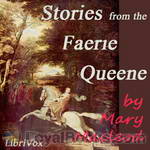 Stories from the Faerie Queene
Stories from the Faerie Queene
"The object of this volume is to excite interest in one of the greatest poems of English literature, which for all its greatness is but little read and known--to excite this interest not only in young persons who are not yet able to read "The Faerie Queene," with its archaisms of language, its distant ways and habits of life and thought, its exquisite melodies that only a cultivated ear can catch and appreciate, but also in adults." (From the Author's introduction) | |
By: Mary Mapes Dodge (1831-1905) | |
|---|---|
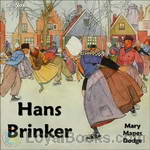 Hans Brinker
Hans Brinker
Mary Mapes Dodge created an instant bestseller with “Hans Brinker or The Silver Skates.” She wanted the book to be partly a book of travels and partly a domestic story. It is a tale written for children that adults also find interesting and uplifting. Dodge writes as if she is sending a series of letters from Holland to children in America, and her you-are-there perspective is aided by a nice attention to detail and vivid imagery.The Brinkers are a poor but stoic family under a dark cloud – Raff, the man of the house, fell from the dikes while reinforcing them during a bad storm, and for ten years he has been in a vegetative state... | |
By: Mary Martha Sherwood (1775-1851) | |
|---|---|
 Fairchild Family
Fairchild Family
The adventures of Lucy, Emily and Henry are described in this short novel, written and set in Regency England. Their naughtiness, their activities and their interactions with the children next door; Miss Augusta and Charles Trueman, are all delightfully described. Their daily lives are an insight into childhood and the family and religious values at the time - each chapter has a moral lesson, and the good end happily, while the bad get what they deserve. | |
By: Mary Raymond Shipman Andrews (1860-1936) | |
|---|---|
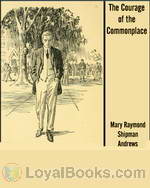 The Courage of the Commonplace
The Courage of the Commonplace
The short story of a young man who came to terms with himself and became a man on a day when he had proven to be a failure to his family, his friends, his classmates, the girl he liked, and most importantly to himself. | |
By: Mary Roberts Rinehart (1876-1958) | |
|---|---|
 The Circular Staircase
The Circular Staircase
A wealthy, middle-aged spinster arrives at the mansion she's rented for the summer while her own town house is being renovated. The mansion is the home of a millionaire local banker, who has left for California with his wife and stepdaughter. But all is not peace and relaxation in the vast villa. Before long, the spinster's house help is frightened out of her wits by various strange noises. What follows is a spooky tale of mysterious disappearances, murder, apparitions and weird goings on. The Circular Staircase by Mary Roberts Rinehart is her first published novel and was wildly popular when it first came out in 1907... | |
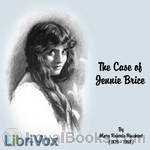 The Case of Jennie Brice
The Case of Jennie Brice
The flood brings in not only the muddy waters but a series of suspicious clues that convinced Mrs. Pitman, a boarding house keeper, that a murder has been committed at her boarding house. Jennifer Ladley aka Jennie Brice is missing and with the help of Mr. Holcombe, a quirky gentleman with a passion for mysteries, they embark on a quest for the truth behind the disappearance of Jennie Brice. | |
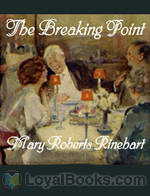 The Breaking Point
The Breaking Point
Mary Roberts Rinehart -- "America's Agatha Christie," as she used to be called -- set this story in a New York suburban town, shortly after the end of the first world war. Dick Livingstone is a young, successful doctor, who in the course of events becomes engaged to Elizabeth Wheeler. But there is a mystery about his past, and he thinks himself honor-bound to unravel it before giving himself to her in marriage. In particular, a shock of undetermined origin has wiped out his memory prior to roughly the last decade... | |
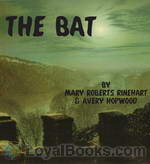 The Bat
The Bat
The novelization of the play of the same name that had an initial run of 867 shows on Broadway and has been performed all over the world and been made into three movies over a span from 1926 to 1959. An intricate mystery, with a wide cast of characters. (Summary by Alan Winterrowd) | |
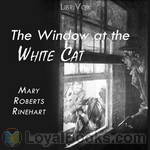 The Window at the White Cat
The Window at the White Cat
When a clumsy, well-meaning lawyer gets involved with a pair of delightful old maids and a beautiful girl, he must acquire some of the skills of his friends the detective and the newspaperman to solve the puzzle of The White Cat. That’s the name of a back-street political club serving beers, political favors and, occasionally, murder. (Introduction by Robert Keiper) | |
 The Amazing Interlude
The Amazing Interlude
It is the early days of The Great War. As the curtain rises, Sara Lee is sitting by the fire in her aunt and uncle’s home, knitting a baby afghan. Her beau’s name is Harvey. He has his eye on a little house that is just perfect for two and he will soon propose to Sara Lee. But in this play, the mise en scène is about to change. A fairyland transformation will take place and Sara Lee will step into a new and different story, where she is the princess in a forest of adventure. There is a prince, too, whose name is Henri... | |
 The Man in Lower Ten
The Man in Lower Ten
Someone had to take the bank notes to Pittsburgh and take a statement from John Gilmore confirming that they were indeed forged. It was McKnight's turn to go, but he was bagging off because he wanted to spend the weekend visiting Alison West in Richmond. And so his law partner, Lawrence Blakeley, is left with no choice but to make the trip himself. All goes well at first, but on the train home, Blakeley wakes to find that the notes, along with his clothes, are missing from his sleeping berth. It was an eventful night. In addition to the theft, there's been a murder in the berth across, and when the weapon is found under Blakeley's pillow, he becomes one of the prime suspects. | |
 The Street of Seven Stars
The Street of Seven Stars
Published in 1914, this novel tells the story of Harmony Wells, an innocent and beautiful American in Austria to study violin. Harmony has talent and she dreams of a career in music. After her friends run out of money and return to the States, Harmony stays on in hopes of earning enough money to continue her lessons. Along the way, she meets Peter Byrne, an American doctor in Vienna following his dream to study surgery. Peter is already watching over an orphan boy in a local hospital and now he takes it upon himself to protect young Harmony from the unsavory side of life in the big city... | |
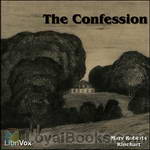 The Confession
The Confession
Mary Roberts Rinehart is claimed to have invented the "Had I but known" mystery genre. When Agnes Blakiston rented the old parsonage at Miss Emily's request she soon came to regret it. Was the house haunted? Did Miss Emily have a secret so terrible she would rather die than reveal it? To find the answers you will need to listen. | |
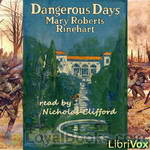 Dangerous Days
Dangerous Days
Dangerous Days opens in a still neutral America, though within a year the country will have joined the European alliance against the Central Powers in the first world war. Clayton Spencer, a successful industrialist and owner of a munitions plant, finds himself facing several problems: not only anarchism and German sabotage, but also the prospect of a deteriorating marriage, and of a son who all too often shares his mother's frivolous and essentially self-concerned point of view. How far will America's entry into the war change such views? What will it mean for Spencer, for his family, and for his business? | |
 When a Man Marries
When a Man Marries
A divorced playboy hosts a dinner party complete with a stand in wife to placate his aunt who financially supports him. When his chef is hospitalized with smallpox symptoms, the fun begins. Throw in an ex-wife, a mystery, and a little romance and you have a comedy of side splitting proportions. - | |
 Tish
Tish
The story of three "middle aged ladies". Follow along as they have all sorts of adventures. | |
 More Tish
More Tish
Mary Roberts Rinehart wrote 6 books about the elderly Letitia (Tish) Carberry and the escapades she gets her elderly lady cronies into. The series led to a 1942 movie with Marjorie Main. This particular book, the third in the series, was written after Mary's stint as a war correspondent in Belgium during the first World War. | |
By: Mary T. Waggaman (1846-1931) | |
|---|---|
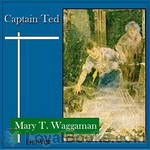 Captain Ted
Captain Ted
When tragedy hits his family, in the form of a sudden illness to his father, young Teddy Thornton is forced to leave school and find work to help support his family. Without his realization he is thrown into a world of crime and counterfeiting. Will he do the right thing, or will he unwittingly be drawn down the wrong path? And will the mystery of Heron Hall be solved? | |
By: Mary Webb (1881-1927) | |
|---|---|
 Gone To Earth
Gone To Earth
“Gone to Earth” is the cry of fox hunters as the fox takes to its den and they lose the chase. Here, Mary Webb tells the story of Hazel Woodus whose understanding of her half tame fox cub contrasts with her misunderstanding of humanity. She is pursued by two very different men, a Gentleman Farmer and the local Minister. Mary Webb’s writing is sometimes compared to that of Thomas Hardy, her descriptions of nature are vivid and her view of love and life is touched with tragedy. She wrote this book in 1917 and it is set in the borderlands of rural Shropshire. | |
By: Mary Wollstonecraft (1759-1797) | |
|---|---|
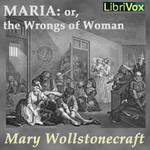 Maria: or, the Wrongs of Woman
Maria: or, the Wrongs of Woman
Maria: or, The Wrongs of Woman is Mary Wollstonecraft's unfinished novelistic sequel to her revolutionary political treatise A Vindication of the Rights of Woman. It was published posthumously in 1798 by her husband, William Godwin. Maria revolves around the story of a woman imprisoned in an insane asylum by her husband, and focuses on the societal rather than the individual "wrongs of woman". Publicised at the same time as Wollstonecraft's memoirs, both were considered scandalous. Not until the 20th century was the novel considered an important historical and feminist work. | |
 Mary: A Fiction
Mary: A Fiction
Eliza, Mary's mother, is obsessed with novels, rarely considers anyone but herself, and favours Mary's brother. She neglects her daughter, who educates herself using only books and the natural world. Ignored by her family, Mary devotes much of her time to charity. When her brother suddenly dies, leaving Mary heir to the family's fortune, her mother finally takes an interest in her; she is taught "accomplishments", such as dancing, that will attract suitors. However, Mary's mother soon sickens and requests on her deathbed that Mary wed Charles, a wealthy man she has never met. Stunned and unable to refuse, Mary agrees. Immediately after the ceremony, Charles departs for the Continent. | |
By: Mary Wollstonecraft Shelley | |
|---|---|
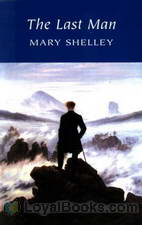 The Last Man
The Last Man
The Last Man is an early post-apocalyptic science fiction novel by Mary Shelley, which was first published in 1826. The book tells of a future world that has been ravaged by a plague. The plague gradually kills off all people. Lionel Verney, central character, son of a nobleman who gambled himself into poverty, finds himself immune after being attacked by an infected “negro,” and copes with a civilization that is gradually dying out around him. | |
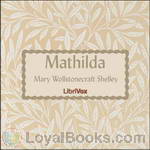 Mathilda
Mathilda
The finished draft of a short novel by Mary Shelley. Its adult theme, concerning a father’s incestuous love for his daughter and its consequences, meant that the manuscript was suppressed by Shelley’s own father, and not published until 1959, more than a hundred years after her death. Summary by Cori Samuel | |
 Tales and Stories
Tales and Stories
While Mary Shelley will most likely always be known for her enduring classic of mad science Frankenstein, this collection intends to show the sheer breath and quality of her writing beyond the creation for which she is most known. Many of these stories are told in an atmospheric gothic fiction vein, full of eerie old castles, strange revelations and family secrets. But we also have stories of the supernatural and even science fiction to contend with. Shelley was a true literary master and should be recognized for her contributions to literature beyond her most famous work. - Summary by Ben Tucker | |
 Lodore
Lodore
The author of Frankenstein returns with her take on an Austen novel. The mother is proud, the father has many vices, yet the aristocratic name must be kept. Even more so when lord Lodore dies. His wife and daughter find themselves without protection. This novel is conserned with gender equality, education and social justice. - Summary by Stav Nisser. | |
 Falkner
Falkner
Falkner is the last novel by Mary Shelley, best known as the author of Frankenstein and The Last Man. It tells the impossible love story between Elizabeth Raby and Gerald Neville. She is an orphan, raised by a tyrannical father figure. The man who raised her drove Gerald Neville's mother to her death years before. Can these men reconcile for the woman both love and start anew? Or would Elizabeth have to give up her happiness? Mary Shelley considered this her best novel. You may read it and see what you think. - Summary by Stav Nisser and Wikipedia. | |
 Frankenstein: or, the Modern Prometheus (Version 4)
Frankenstein: or, the Modern Prometheus (Version 4)
This is a classic horror story, and one of the earliest examples of science fiction. The main characters are Dr. Frankenstein and his creation, the daemon. Shelley called the scientist a "pale student of unhallowed arts" and his creation a "hideous phantasm of a man." This story is not only delightfully frightful, but arguably represents one of the clearest criticisms of science during a time when, like the daemon, it was leaving its own infancy and, like Dr. Frankenstein, testing its ethical boundaries... | |
 Frankenstein, or The Modern Prometheus (Edition 1831)
Frankenstein, or The Modern Prometheus (Edition 1831)
A mentally unstable genius, Victor Frankenstein, inspired by the dreams of ancient alchemists and empowered by modern science, creates a humanoid but fails to nurture and educate it after it comes to life. It wanders alone into a hostile world, where fear of its size and ugliness subjects it to violence and ostracism, which in time it learns to blame upon its maker. As compensation for its suffering, it demands that he create a companion with whom to share its outcast life. Moved by the creature's account of its sufferings, the scientist agrees, but a long period of procrastination awakens doubts that ultimately cause him to break his promise... | |
By: Matthew Lewis | |
|---|---|
 The Monk: A Romance
The Monk: A Romance
Matthew Gregory Lewis's The Monk: A Romance is a story of frustrated and unrequited desire between mentor and pupil mixed with elements of the supernatural. It includes several subplots: rape, torture and incest. It is the old story of the forces of good versus the forces of evil, except that in this one evil comes out ahead. When The Monk was first published in 1795, it was received well by readers and reviewers causing a second edition to be printed the following year. But by the third year, there began a growing criticism of the book and of Lewis mostly on the basis of immorality... | |
 Adelgitha; or, The Fruits of a Single Error
Adelgitha; or, The Fruits of a Single Error
The second original tragedy written by Gothic writer Matthew Lewis, Adelgitha; or, The Fruits of a Single Error is a markedly more serious affair than his melodramatic output, dealing as it does with a fallen woman who is mercilessly blackmailed by a ruthless tyrant when she spurns his advances. Set in Otranto during the High Middle Ages, and featuring fictionalized depictions of historical rulers Robert Guiscard and Michael Ducas , Adelgitha is an archetypal Gothic drama that, while not especially refined or meritorious in terms of quality, still manages to thrill in that deliciously overwrought way that Lewis knew how to sell... | |